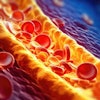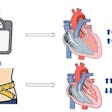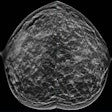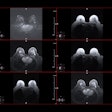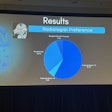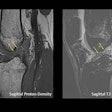The Schilling Test
In normal subjects, ingested B12 forms a complex with intrinsic factor, a protein secreted by the parietal cells of the gastric fundus. This complex binds to specific receptors in the terminal ileum in the presence of an alkalline pH and calcium, where B12 is actively transported across the mucosa. The total body stores of B12 are so high that it requires 3 to 5 years to develop deficiency if intake is halted or malabsorption occurs. Causes of B12 deficiency include:
- Absence of intrinsic factor secondary either to pernicious anemia, or gastrectomy (absence of parietal cells in the fundus)
- Inadequate absorption of B12 secondary to sprue, regional enteritis (Crohn's disease), bacterial overgrowth, short bowel syndrome, pancreatic insufficiency, or medications that chelate calcium which is required for absorption.
The Schilling Test was introduced in 1953 for in vivo evaluation of vitamin B12 absorption. Humans obtain vitamin B12 primarily in a protein-bound form from animal products, as well as additional sources such as soy bean, sea vegetables and milk. Vitamin B12 is a precursor of DNA synthesis and lack of vitamin B12 will impair DNA synthesis within a cell, however, RNA and protein synthesis are unaffected. This results in a dissociation between nuclear and cytoplasmic maturation, producing cells which have an enlarged mature cytoplasm and an immature nucleus (megaloblastosis). These findings are most prominent in cells with rapid turnovers such as blood and GI tract. That is why B12 deficiency can lead to hematologic changes such as megaloblastic anemia or megaloblastic changes in the GI tract. If these megaloblastic changes occur in the terminal ileum, vitamin B12 absorption is inhibited. Vitamin B12 is also required for myelin metabolism; therefore deficiency can cause neurologic symptoms, classically involving the posterior columns and peripheral nerves leading to loss of position and vibratory sensation as well as peristhesias (subacute combined degeneration of the spinal cord).
Vitamin B12 absorption physiology
- Ingested B12 is released from protein by digestive enzymes (gastric acid and pepsin).
- B12 binds to R protein in the stomach. R protein is found in gastric, biliary and salivary secretions.
- Pancreatic enzymes degrade B12-R and facilitate binding of B12 to Intrinsic factor (IF - this is produced by the parietal cells in the fundus and body of the stomach) which occurs in the presence of an alkaline pH.
- B12-IF is absorbed by the terminal ileum.
- B12 enters serum bound to Transcobalamin-I (75%) and Transcobalamin-II (25%).
Indications for the Schilling Test
- Low serum B12 level with or without hematologic or neurologic symptoms. 2/3 of patients with low B12 have no signs or symptoms.
- Confirm the diagnosis of vitamin B12 malabsorbtion and determine the mechanism.
- Hematologic changes with non-diagnostic serum tests. This includes a macrocytic anemia which may involve a decrease in platelet and WBC count as well. Neutrophils will classically be hypersegmented with >5 nuclear lobules.
- Detect patients at risk for becoming B12 deficient (e.g. post gastrectomy, ileal disease, family history of pernicious anemia).
- To determine if a patient on long term vitamin B12 therapy actually has an absorption defect.
The Schilling test is most commonly used for evaluation of pernicious anemia. Pernicious anemia is the most common cause of vitamin B12 deficiency. Pernicious anemia is characterized by the presence of anti-parietal cell and anti-intrinsic factor antibodies (50-80%) leading to intrinsic factor deficiency, gastric mucosal atrophy, and achlorhydria. Approximately 90% of patients with pernicious anemia have anti-parietal cell antibodies, however, 50% of people with these antibodies do not have pernicious anemia. Other causes of intrinsic factor deficiency include: destruction of gastric mucosa from corrosives or malignancy, and gastric atrophy secondary to iron deficiency anemia, multiple sclerosis or gastric resection. Neurologic defects are the most severe consequences of this disease, as they may not be reversible even after therapy, unlike the hematologic sequelae which respond quickly to therapy. Pernicious anemia is associated with other autoimmune disorders such as Graves disease, Hashimotos thyroiditis and vitiligo. The incidence of gastric cancer is also increased in these patients.
Pre-Test Preparation
- Confirm B12/ Folate levels have been drawn and that the patient has a low B12. A normal B12 level virtually excludes B12 deficiency. The reason for this is that you can't check these labs after performing the test since vitamin B12 is given as part of the study. Folate deficiency can cause a megaloblastic anemia exactly the same as B12 deficiency except neurologic symptoms do not occur.
- Ensure overnight fasting. The vitamin B12 from a meal can affect absorption (decrease it) leading to a false positive test.
- Confirm that no parenteral vitamin B12 has been given within the last three days. Enterohepatic circulation will compete with B12 absorption from the ileum.
Causes of false low serum B12 level
- Megaloblastic anemia secondary to folate deficiency
- Veganism
- Third trimester pregnancy
- Contraceptives and anti-convulsants
- Multiple myeloma
- TC-I deficiency
- Radioactivity present in the serum from a prior nuclear study (Gallium, Technetium)
Causes of false normal B12
- Recent parenteral vitamin B12
- Nitrous oxide inhalation
- Severe liver disease
- Chronic granulocytic leukemia
- TC-II deficiency
- Lab error
[Clementz, G. The Spectrum of Vitamin B12 Deficiency. AFP 1990;41(1).] [Diagnostic Nuclear Medicine 3rd Edition, vol2]
Stage I Schilling Test
Technique
The patient is given 0.5uCi Co-57 (T1/2 = 270 days, gamma 122KeV) labeled B12 (0.5ug of B12) orally and instructed to fast for two hours. The dose of vitamin B12 should not exceed 1ug as this may lead to a false positive study. A 24 hour urine collection is initiated. The patient is then given 1000ug of vitamin B12 IM two hours after the oral dose (this should be given within six hours). The purpose of this is to saturate B12 binding sites in the body. Any of the absorbed oral B12 cannot bind to the already saturated transcobalamine proteins, and will be excreted in the urine by glomerular filtration. The percentage of the administered dose excreted in the urine over 24 hours is then determined. Normally greater than 9% of the administered dose will be excreted in the urine. In patients with pernicious anemia or intestinal malabsorption, the urinary excretion is usually less than 6%. Values between 6 to 10% are considered to be indeterminant.
Calculations
- Count the 4.0 ml standard solution and the Co-57-B12 capsule in a well counter for one minute.
- Calculate the capsule-standard ratio as follows:
- C.S.R. = Capsule CPM / (Standard CPM x 100)
- The standard solution contains the equivalent of 1% of the total radioactivity in the oral dose.
- Mix the urine sample thoroughly and pipette two 4ml aliquots into counting vials.
- Count the urine sample, reference standard, and 4ml of water as a background for 20min using the Co-57 window.
- Calulate the percent urine excretion of labeled B12 as follows:
- (Avg. Cts. Of urine - Bkg. Cts.) x (Total urine vol. /
4) x 100
% U.E.= ---------------------------------------------------------------
Cap-std. ratio x (Std. Cts. - Bkg) x 100
Causes for a false positive test
(May occur in up to14% of cases)
- Incomplete urine collection (most common cause). Maximum urinary excretion of the absorbed labeled B12 occurs 5 to 8 hours post-administration. Loss of even one urine sample during this time can produce a false-positive result (i.e.: a falsely low B12 excretion).
- Renal failure or obstruction: The labeled vitmin B12 is excreted by glomerular filtration which may be severely diminished with renal disease, thus a longer collection is needed to allow for the slower excretion of B12 in these patients. In these patients measure the urine creatinine, which should be > 15mg/kg/day. A 48 hour urine collection may be needed in these patients
- Chronic B12 deficiency can lead to atrophy of the ileal mucosa, which itself can decrease intestinal absorptive ability. In these cases, phase 2 of the exam may not correct despite the use of Co-57 B12-IF. In these patients, a repeat phase 2 should be performed after several weeks to months of B12 therapy. This permits the intestinal mucosa to recover and the test should normalize.
- When the amount of oral B12 ingested is increased, the intestinal absorption will actually decrease and a false positive test may be obtained. It is important not to use more than 1 ug of B12 because of this reason.
- The radioactive B12 given in the oral dose is a crystalline form. Investigators have shown that patients with normal crystalline B12 absorption (normal phase 1 exam), may actually have abnormal absorption of food-bound B12. This deficiency can be identified by performing the exam with Co-57 labeled B12 complexed with egg yolk.
Causes for a false negative test
Absorption of crystalline B12 as used in the test capsule does not imply absorption of protein bound B12 as found in foods. Common causes of inability to absorb protein bound vitamin B12 include:
- Old age.
- H2 blockers and iron deficiency anemia which lead to decreased gastric pH.
- Alcohol and folate deficiency.
- A prior study with another radiopharmaceutical such as technetium which has a similar energy.
- Fecal contamination. Female patients, particularly if they have diarrhea can contaminate the urine collection with labeled B12 that was never absorbed.
Stage II Schilling Test
Performed if stage I is abnormal, and should be done at least 3-4 days after the last test. The patient is given 0.5uCi Co-57 labeled B12 with intrinsic factor (we use a separate 60 mg capsule of intrinsic factor). A flushing dose of intramuscular B12 and 24 urine collection are performed as in stage I. In patients with pernicious anemia, stage II will be normalize, while patients with intestinal malabsorbtion / maldigestion will still have an abnormal test. At this point the patient may proceed to a stage III test or stage I may be repeated after 3-4 months of intramuscular B12 therapy. The rationale for this is that prolonged vitamin B12 deficiency may lead to megaloblastic changes of the terminal ileum which itself can result in B12 malabsorption. After 3-4 months of therapy, abnormalities within the terminal ileum may resolve and absorption of B12 may return to normal.
Stage III Schilling Test
If stage I and II are abnormal the patient may be treated with antibiotics such as tetracycline for 1-2 weeks. The test is then performed as in Stage II with Co-57 labeled B12 and intrinsic factor. In patients with intestinal malabsorption due to bacterial overgrowth, the test should normalize.
Intestinal malabsorption has many causes, to include processes which lead to unavailability of vitamin B12 (Bacterial competition for B12, Fish tapeworm) or intestinal defects (Crohns disease, ileal resection, celiac disease, intestinal lymphoma, Whipples disease, and megaloblastic changes of the terminal ileum).
Stage IV Schilling Test
This phase involves administering Co-57 labeled B12 after the patient has been given pancreatic enzymes for three days. In patients with B12 deficiency due to pancreatic insufficiency, the test should normalize.
Pancreatic abnormalities are a rare cause for vitamin B12 deficiency and are due to maldigestion. Pancreatic deficiency prevents degredation of B12-R protein and binding of B12-Intrinsic factor. Diseases such as Zollinger-Ellison are associated with a decreased duodenal pH that inactivates pancreatic enzymes and prevents B12-IF binding.
Dual-isotope Schilling test
This may be performed to shorten study time by combining stage I and stage II. The patient is given Co-58 (T1/2= 71 days, gamma 810 KeV) labeled B12 and Co-57 labeled B12 with intrinsic factor. Since the two isotopes have different energies, they can be counted separately if a correction for crosstalk is made. The problem with this test is that in the acidic environment of the stomach, exchange of Co-57 and Co-58 may occur giving non-diagnostic results. In this test three values are determined:
- Excretion of Co-57-B12-IF (Bound B12)
- Excretion of Co-58-B12 (Free B12)
- Ratio of Co-57-B12-IF : Co-58-B12 (Bound : Free)
Interpretation is as follows:
| Normal | Pernicious Anemia | Malabsorption | |
| Free B12 % | 10-40 | 0-7 | <6 |
| Bound B12 % | 10-42 | 6-12 | <6 |
| Bound : Free | 0.7-1.3 | >1.7 | 0.7-1.3 |
[*Zuckler, L & Rao Chervu, L. Schilling Evaluation of Pernicious Anemia: Current Status. JNM 1984; 25. ]
One advantage of this method is that by using a Bound : Free ratio, interpretation can
be made in the presence of inadequate urine collection.
